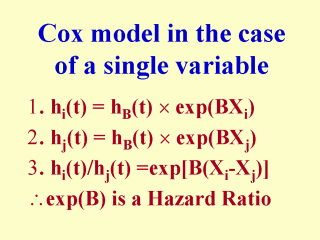| front |1 |2 |3 |4 |5 |6 |7 |8 |9 |10 |11 |12 |13 |14 |15 |16 |17 |18 |19 |20 |21 |22 |23 |24 |25 |26 |27 |28 |29 |30 |review |
 |
Let hi(t) and hj(t)
be the hazard functions for subjects with value i and j on variable X. B is a regression
coefficient to be estimated. In a clinical trial, for instance, i=1 for a treatment group
and i=0 for a control group. hB(t) is an unspecified baseline hazard function.
When the hazard ratio (HR) is estimated, the hB(t) in the numerator and
denominator cancels out itself, i.e. HR=hi(t)/hj(t)=exp(BXi)/exp(BXj)=exp[B(Xi-Xj)]. Since Xi is coded as 1 (treatment) and Xj as 0 (control), B indicates the treatment effect in terms of a log HR. The Cox model is semi-parametric in a sense that it is not concerned with the pattern of the baseline hazard, hB(t), but it assumes the same pattern of hB(t) in the numerator and denominator. The estimation is based on a method called maximum partial likelihood (Cox, 1972). |